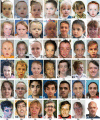Further delineation of Malan syndrome
- PMID: 29897170
- PMCID: PMC6175110
- DOI: 10.1002/humu.23563
Further delineation of Malan syndrome
Abstract
Malan syndrome is an overgrowth disorder described in a limited number of individuals. We aim to delineate the entity by studying a large group of affected individuals. We gathered data on 45 affected individuals with a molecularly confirmed diagnosis through an international collaboration and compared data to the 35 previously reported individuals. Results indicate that height is > 2 SDS in infancy and childhood but in only half of affected adults. Cardinal facial characteristics include long, triangular face, macrocephaly, prominent forehead, everted lower lip, and prominent chin. Intellectual disability is universally present, behaviorally anxiety is characteristic. Malan syndrome is caused by deletions or point mutations of NFIX clustered mostly in exon 2. There is no genotype-phenotype correlation except for an increased risk for epilepsy with 19p13.2 microdeletions. Variants arose de novo, except in one family in which mother was mosaic. Variants causing Malan and Marshall-Smith syndrome can be discerned by differences in the site of stop codon formation. We conclude that Malan syndrome has a well recognizable phenotype that usually can be discerned easily from Marshall-Smith syndrome but rarely there is some overlap. Differentiation from Sotos and Weaver syndrome can be made by clinical evaluation only.
Keywords: Malan syndrome; Marshall-Smith syndrome; NFIX; Sotos syndrome; Weaver syndrome; phenotype; phenotype-genotype.
© 2018 The Authors. Human Mutation published by Wiley Periodicals, Inc.
Figures


References
-
- Aggarwal, A. , Nguyen, J. , Rivera‐Davila, M. , & Rodriguez‐Buritica, D. (2017). Marshall‐Smith syndrome: Novel pathogenic variant and previously unreported associations with precocious puberty and aortic root dilatation. European Journal of Medical Genetics, 60, 391–394. 10.1016/j.ejmg.2017.04.01 - DOI - PubMed
Publication types
MeSH terms
Substances
Supplementary concepts
Grants and funding
LinkOut - more resources
Full Text Sources
Other Literature Sources
Medical

